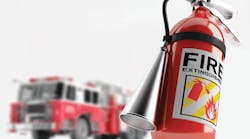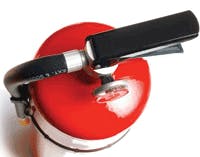I have been in the fire service for over 30 years and have conducted hundreds of live fire extinguisher trainings for all different types of companies. One common theme throughout these trainings is that not every employee was willing to risk his or her life to save the property or business by using a portable fire extinguisher.
I also have witnessed many instances where employees were unwilling to use a portable fire extinguisher during a controlled live fire extinguisher training.
See Also: Occupational Health & Safety (OHS) Training
As this is a passion for me, I started a business that addressed the need for employees to learn how to use and feel comfortable with portable fire extinguishers. I was contracted by many different type companies to conduct live fire training. The trainings that were conducted had safety as the No. 1 priority. There was a 2:1 safety ratio, two instructors for each participant. There was one instructor controlling the fuel source and one instructor with each student to guide and assist the employee on how to properly use the extinguisher.
Since OSHA has omitted or deleted the requirement for live fire training, my side business disappeared and so did live fire training. Some businesses within my fire department district still utilize live fire training programs, but they are becoming fewer and fewer every year.
| Option 1 | Option 2 | Option 3 | Option 4 |
|
Total evacuation of employees from the workplace mmediately
when alarm sounds. No one is authorized to use available portable fire
extinguishers.
|
Designated employees are authorized to use portable fire extinguishers to fight
fires. all other employees
must evacuate the workplace immediately when alarm sounds.
|
All employees are authorized to use
portable fire
extinguishers to fight fires.
|
Extinguishers are provided but not
intended for
employee use.
|
| Requirement | Requirement | Requirement | Requirement |
|
Establish an emergency
action plan, fire
prevention plan and train employees accordingly.
Extinguishers are not existing and not required
[29 cFR 1910.157(b)(1)].
|
Establish an emergency
action plan and train
employees accordingly.
meet all general fire
extinguisher requirements
plus annually train
designated employees
to use fire extinguishers.
Fire extinguishers in
the workplace must be
inspected, tested, and
maintained [29 cFR
1910.157(b)(2)].
|
If any employees will be
evacuating, establish an emergency action plan and train employees
accordingly. meet all
general fire extinguisher
requirements plus annually train all employees to
use fire extinguishers.
Fire extinguishers in the workplace must be inspected, tested, and
maintained [29 cFR
1910.157(b)(2)].
|
Establish an emergency
action plan, fire
prevention plan and train
employees accordingly.
If fire extinguishers are left in the workplace,
they must be inspected,
tested, and maintained.
Extinguishers are
provided but not
intended for employee
use [29 cFR 1910.157(a)].
|
While OSHA acknowledges live fire training as going above and beyond the minimum training, the agency has published a flow chart for employers who may choose to have their employees use a portable fire extinguisher in the workplace.
So what does that mean for industry and your business? You cannot expect that your employees will use the fire extinguisher you have made available, especially without training.
Fire Extinguisher Training
OSHA, in my opinion, gives business a great deal of latitude in determining the appropriate level of training. Fire extinguisher training can be as simple as "this is the extinguisher, this is how it works and these are the types of fires it will extinguish." Does this "training" alone make employees feel comfortable using a fire extinguisher and ensure that their safety needs are met?
We all can watch videos and listen to a lecture, but without the hands-on experience, the training is lacking.
What else should the employee know? What are you teaching in your pre-employment and annual fire extinguisher trainings? Is your business even conducting this necessary but often overlooked training?
I challenge EHS managers to sit through their company's training for fire extinguisher safety and ask yourself this question: If I had no other knowledge of this device, would I be able to use it and feel my safety wouldn't be compromised? If you can answer yes, then you have a good fire extinguisher training program. But if you answer no, then it is time to reevaluate your program.
|
Risk Assessment
Question
|
Characteristics of incipient
stage fires or fires that can be
extinguished with portable fire extinguishers
|
Characteristics of fires that SHOULD NOT be fought with a portable fire extinguisher (beyond incipient stage)
- evacuate immediately
|
| Is the fire too big? |
The fire is limited to the original
material ignited, it is contained
(such as in a waste basket) and
has not spread to other materials.
The flames are no higher than the
firefighter’s head.
|
The fire involves flammable solvents, has spread over more than 60 square feet, is partially hidden behind a wall or ceiling, or can not be reached from a standing position.
|
|
Is the air safe to breathe?
|
The fire has not depleted the oxygen in the room and is producing only small quantities of toxic gases. no respiratory protection equipment is required.
|
Due to smoke and products of combustion, the fire can not be fought without respiratory protection.
|
|
Is the environment
too hot or smoky?
|
Heat is being generated, but the room temperature is only slightly increased. Smoke may be accumulating on the ceiling, but visibility is good. no special personal protective equipment
is required.
|
The radiated heat easily is felt on
exposed skin, making it difficult to
approach within 10-15 feet of the fire
(or the effective range of the extinguisher). one must crawl on the floor due to heat or smoke. Smoke is quickly filling the room,
decreasing visibility.
|
|
Is there a safe
evacuation path?
|
There is a clear evacuation path that is behind you as you fight the fire.
|
The fire is not contained and fire, heat or smoke may block the evacuation path.
|
Elements of a Good Training Program
As I stated earlier, not all employees are willing to use a portable fire extinguisher to protect your property. There is a myriad of reasons for this. Don't allow your fire extinguisher training be the deciding factor.
So, what goes into a good program? Glad you asked!
If you want to protect workers and the workplace, consider incorporating these elements into your fire extinguisher training program:
➠ Teach all employees how to use a pull station.
➠ Ensure employees know their exit routes and clearly mark those exits and keep them unobstructed. Having a sound, executable evacuation plan will do wonders when working with your local fire department. The first-arriving firefighter immediately will ask, "Is everyone out of the building?" If the answer is yes, then the fire department will concentrate their efforts on property conservation. If the answer is no or I don't know, then the fire department is going to utilize a great deal of resources to make sure no one is inside and fire suppression gets put on the back burner (so to speak).
➠ Have a designated rally point with a team/group leader should an emergency occur. Having a solid exit plan, rally point and team leader goes a long way in helping direct the resources of the fire service away from search and rescue, allowing them to concentrate on property conservation since employees will be safe and accounted for.
➠ Conduct spot drills and see if your training really works or just looks good on paper.
A good, portable fire extinguisher training program helps your employees feel safe and confident in suppressing a fire in its incipient phase. If a fire is not stopped in that early phase, then it will grow exponentially, doubling its size every minute. Having a good portable fire extinguisher training program is well worth the expense of downtime or overtime.
Finally, remember this last word of advice: there is a "one extinguisher rule." If a fire can't be put out with a single fire extinguisher, then everyone needs to evacuate and call the local fire department.
Scott J. Murray is a battalion chief of the Central Coventry Fire District in Coventry, R.I. He is the training/health and safety officer and is nationally certified (NFPA 1041 & 1521). He holds an A.S. in fire science from the Community College of Rhode Island and is an instructor/coordinator for the Rhode Island Fire Academy, a member of the Rhode Island Fire Chiefs Association and currently is pursuing a degree in EHS.

